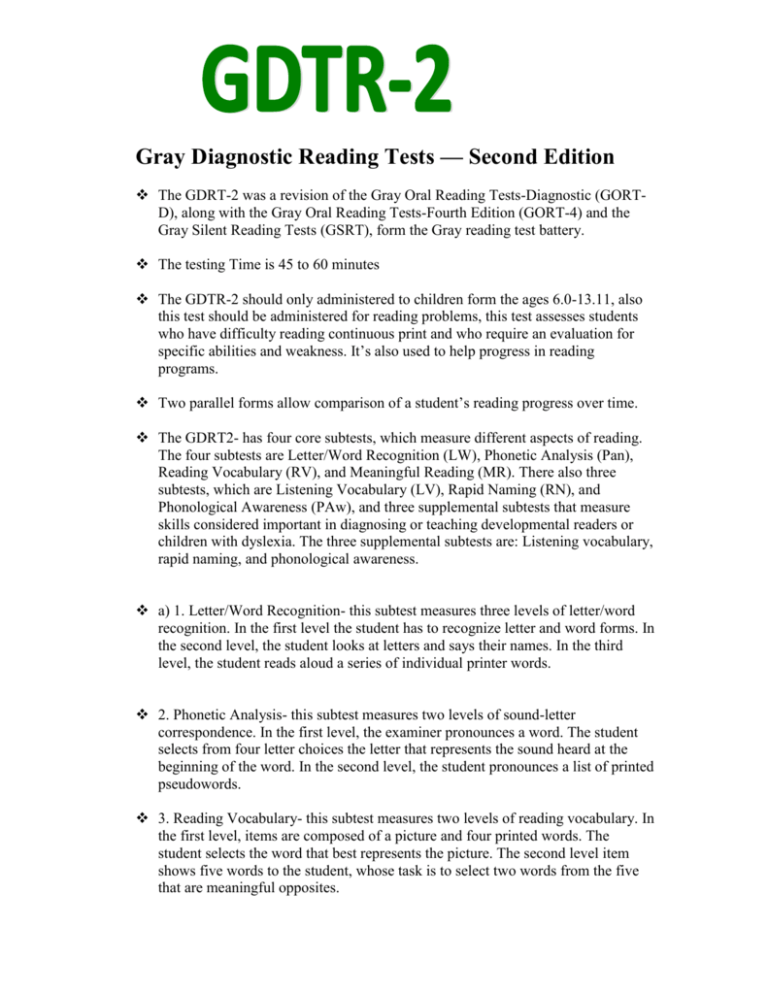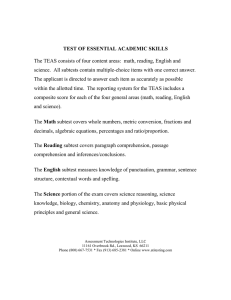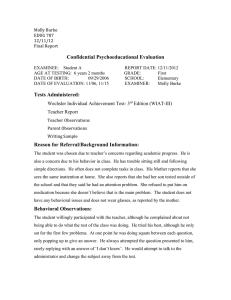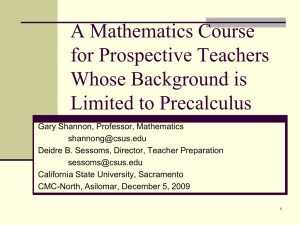Gray Diagnostic Reading Tests — Second Edition
advertisement

Gray Diagnostic Reading Tests — Second Edition The GDRT-2 was a revision of the Gray Oral Reading Tests-Diagnostic (GORTD), along with the Gray Oral Reading Tests-Fourth Edition (GORT-4) and the Gray Silent Reading Tests (GSRT), form the Gray reading test battery. The testing Time is 45 to 60 minutes The GDTR-2 should only administered to children form the ages 6.0-13.11, also this test should be administered for reading problems, this test assesses students who have difficulty reading continuous print and who require an evaluation for specific abilities and weakness. It’s also used to help progress in reading programs. Two parallel forms allow comparison of a student’s reading progress over time. The GDRT2- has four core subtests, which measure different aspects of reading. The four subtests are Letter/Word Recognition (LW), Phonetic Analysis (Pan), Reading Vocabulary (RV), and Meaningful Reading (MR). There also three subtests, which are Listening Vocabulary (LV), Rapid Naming (RN), and Phonological Awareness (PAw), and three supplemental subtests that measure skills considered important in diagnosing or teaching developmental readers or children with dyslexia. The three supplemental subtests are: Listening vocabulary, rapid naming, and phonological awareness. a) 1. Letter/Word Recognition- this subtest measures three levels of letter/word recognition. In the first level the student has to recognize letter and word forms. In the second level, the student looks at letters and says their names. In the third level, the student reads aloud a series of individual printer words. 2. Phonetic Analysis- this subtest measures two levels of sound-letter correspondence. In the first level, the examiner pronounces a word. The student selects from four letter choices the letter that represents the sound heard at the beginning of the word. In the second level, the student pronounces a list of printed pseudowords. 3. Reading Vocabulary- this subtest measures two levels of reading vocabulary. In the first level, items are composed of a picture and four printed words. The student selects the word that best represents the picture. The second level item shows five words to the student, whose task is to select two words from the five that are meaningful opposites. 4. Meaningful Reading- this subtest has two levels of meaningful reading, which were assessed. In the first level basic reading skills are assessed. At the second level, the students’ understanding of passages is assessed using cloze procedure, which is when words are deleted from the passage. 1. Listening Vocabulary- this uses to conventional point to the picture of the word I say format to measure receptive vocabulary. 2. Rapid Naming- the student views row of known letters and words and says aloud as many as they can and as fast as they can. 3. Phonological Awareness- the student hears a word, repeats it, and says the word again, deleting a designated phoneme sound or group. Raw scores can be converted to grade- and age-equivalent scores, standard scores, and percentile ranks. The GDRT-2 was normed in 2001-2002 on a sample of 1,018 students ages 6 through 18. The normative sample was stratified to match key demographic variables. Basal: A Basel represents the lower limit of testing, for the GDRT2 it usually consists of five consecutive items of the test that are answered correctly. However, there are two expectations to this rule, which are meaningful reading and rapid naming subtest. The basal for the (MR) subtest is all words correct in two consecutive stories; the (RN) subtest doesn’t have a basal. Ceiling: a ceiling represents the upper limit of testing and usually consists of the first five consecutive items that are answered incorrectly. Again, the (MR) and the (RN) subtests are exceptions to this rule. The ceiling for the (MR) subtest is at least 50% of the words incorrect in two consecutive stories; the (RN) subtest doesn’t have a ceiling, although it does have a two-minute time limit. Materials: GDRT2 has seven components: Examiners manual, Student Book Form A, Student Book Form B, Examiner Record Booklet Form A, Examiner Booklet Form B, and a Storybook (Adventures in Fancyland). Content-description validity- showing that the abilities measured are consistent with the current knowledge about a particular area. Criterion-prediction validityindicates the effectiveness of a test in predicting an individual’s performance in specific activities. Construct-identification validity- is the extent to which the test may be said to measure a theoretical construct of a trait. Absence of culture, gender, race, and disability bias. The test overall is very reliable and valid because the authors gave many researched based items that can test how reliable and valid a test is. This test is highly recommended to give to students who need to be tested in reading.











